The Egyptian Stelae in the Levant are the approximately 25 Ancient Egyptian stelae discovered in the Levant, today known as Syria, Lebanon, Israel, Palestine and Jordan.[1] The most notable examples are the Stelae of Nahr el-Kalb and the Beisan steles.
Only five pharaohs are represented: Thutmosis III and his son Amenophis II (1479 - 1401 BC, both 18th dynasty), Seti I and his son Ramesses II and (1290 BC to 1213 BC, both 19th dynasty), and Shoshenq I (943–922 BC, 22nd dynasty).
List of known stelae
| Original location | Image | Pharaoh / year | Preservation | Discovery date | Current location | Ref. |
|---|---|---|---|---|---|---|
| Stelae of Nahr el-Kalb |  | Ramesses II, year 4 | rock-stela, eroded | 1697 | in situ | [2] |
 | Ramesses II, year 10 | rock-stela, eroded | 1697 | |||
_in_Lepsius'_Denkmaler_(cropped).jpg.webp) |
Ramesses II | rock-stela, eroded, vandalized in 1860/61 | 1697 | |||
| Aadloun stele |  | Ramesses II | rock-stela, eroded since destroyed | ? | in situ, now destroyed | |
| Al-Shaykh Saad | 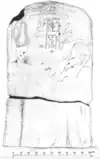 | Ramesses II | complete, eroded | 1891 | (unknown) | [3] |
| Tell Shihab |  | Seti I | Fragment | 1901 | Istanbul | [4] |
| Byblos |  |
Ramesses II, year 4 | Two fragments | 1919 | Beirut | |
| Tell al-Nabi Mando | 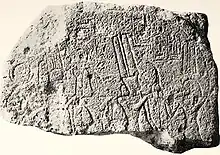 | Seti I | Fragment | 1921 | Aleppo | |
| Beisan steles | 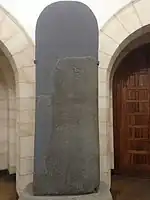 | Seti I | Fragment | 1921 | Rockefeller Archeological Museum | |
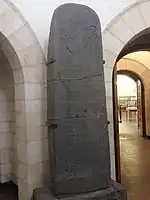 | Seti I, year 1 | Complete | 1923 | |||
_Egypt_Penn_Museum.jpg.webp) | Ramesses II, year 18 | Complete | 1923 | Penn Museum | ||
| Ramesses II | Two fragments | 1923, 1925 | Jerusalem and Penn Museum | [5] | ||
| Tel Megiddo | 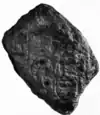 | Sheshonq I | Fragment | 1925-29 | Jerusalem | [6][7] |
| Tell el-'Oreimeh | Thutmosis III or Amenophis II | Fragment | 1928 | Deganya | [8] | |
| Byblos | Thutmosis III (?) | Fragment | 1933-38 | Beirut | ||
| Tyre | Seti I | Two fragments | 1960s | |||
| Ramesses II | Fragment | 1960s | ||||
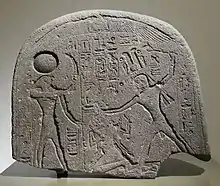 | Ramesses II | Fragment | prior to 1975 | |||
| Al-Kiswah | Ramesses II, year 56 | Fragment | 1994 | Damascus | ||
| at-Turra | Ramesses II | Fragment | 1999 | in situ | ||
| Maydaa | 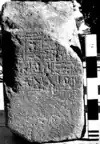 |
2010 | [9] |
See also
Bibliography
- Wimmer, Stefan Jakob [in German] (2002). "A New Stela of Ramesses II in Jordan in the Context of Egyptian Royal Stelae in the Levant". Universitätsbibliothek der Ludwig-Maximilians-Universität München. doi:10.5282/UBM/EPUB.14236. Retrieved 2023-04-17.
- Weinstein, James M. (1981). "The Egyptian Empire in Palestine: A Reassessment". Bulletin of the American Schools of Oriental Research. American Schools of Oriental Research (241): 1–28. doi:10.2307/1356708. eISSN 2161-8062. ISSN 0003-097X. JSTOR 1356708. S2CID 164015977. Retrieved 2023-04-23.
References
- ↑ Wimmer, Stefan Jakob [in German] (2002). "A New Stela of Ramesses II in Jordan in the Context of Egyptian Royal Stelae in the Levant". Universitätsbibliothek der Ludwig-Maximilians-Universität München. doi:10.5282/UBM/EPUB.14236. Retrieved 2023-04-17.
- ↑ Weißbach, Franz Heinrich [in German] (1922), Theodor Wiegand (ed.), "Die Denkmäler und Inschriften an der Mündung des Nahr el-Kelb", Wissenschaftliche Veröffentlichungen des deutsch-türkischen Denkmalschutz-Kommandos, de Gruyter (6)
- ↑ Schumacher, G. (1891). "Der Hiobstein, Sachrat Eijub, im Hauran". Zeitschrift des Deutschen Palästina-Vereins. Deutscher verein zur Erforschung Palästinas. 14: 142–147. ISSN 2192-3124. JSTOR 27928608. Retrieved 2023-04-18.
- ↑ Smith, 1901, p. 347 ff
- ↑ https://www.penn.museum/collections/object/198551
- ↑ Chapman III, Rupert L. (2009). "Putting Sheshonq I in his Place". Palestine Exploration Quarterly. Informa UK Limited. 141 (1): 4–17. doi:10.1179/174313009x387617. ISSN 0031-0328. S2CID 218661383.
- ↑ "OIC 4. The Excavation of Armageddon". Institute for the Study of Ancient Cultures. Retrieved 2023-04-21.
- ↑ Albright, W. F.; Rowe, Alan (1928). "A Royal Stele of the New Empire from Galilee". The Journal of Egyptian Archaeology. Egypt Exploration Society. 14 (3/4): 281–287. doi:10.1177/030751332801400157. ISSN 0307-5133. JSTOR 3854305. S2CID 194005637. Retrieved 2023-04-18.
- ↑ Lagarce, Bérénice (2010). "UNE STÈLE RAMESSIDE À MEYDAA (RÉGION DE DAMAS) ET LA PRÉSENCE ÉGYPTIENNE EN UPÉ". Syria. Institut Francais du Proche-Orient. 87 (87): 53–68. doi:10.4000/syria.652. ISSN 0039-7946. JSTOR 41681330. S2CID 193681904. Retrieved 2023-04-17.<
This article is issued from Wikipedia. The text is licensed under Creative Commons - Attribution - Sharealike. Additional terms may apply for the media files.